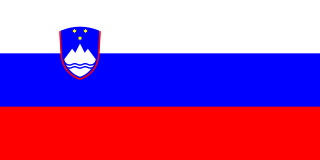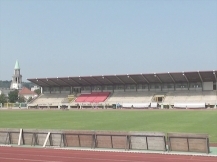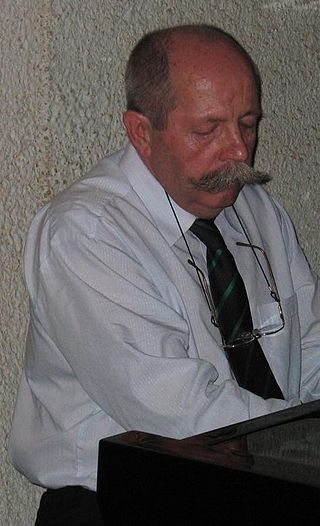Related Research Articles

Slovenia officially the Republic of Slovenia is a country in Europe. It borders Italy to the west, Austria to the north, Hungary to the northeast, Croatia to the south and southeast, and a short coastline within the Adriatic Sea to the southwest, which is part of the Mediterranean sea. Slovenia is mostly mountainous and forested, covers 20,271 square kilometres (7,827 sq mi), and has a population of approximately 2.1 million. Slovene is the official language. Slovenia has a predominantly temperate continental climate, with the exception of the Slovene Littoral and the Julian Alps. Ljubljana, the capital and largest city of Slovenia, is geographically situated near the centre of the country. Other larger urban centers are Maribor, Kranj, Celje and Koper.
The history of Slovenia chronicles the period of the Slovenian territory from the 5th century BC to the present. In the Early Bronze Age, Proto-Illyrian tribes settled an area stretching from present-day Albania to the city of Trieste. The Slovenian territory was part of the Roman Empire, and it was devastated by the Migration Period's incursions during late Antiquity and the Early Middle Ages. The main route from the Pannonian plain to Italy ran through present-day Slovenia. Alpine Slavs, ancestors of modern-day Slovenians, settled the area in the late 6th Century AD. The Holy Roman Empire controlled the land for nearly 1,000 years. Between the mid-14th century through 1918 most of Slovenia was under Habsburg rule. In 1918, most Slovene territory became part of the Kingdom of Serbs, Croats, and Slovenes, and in 1929 the Drava Banovina was created within the Kingdom of Yugoslavia with its capital in Ljubljana, corresponding to Slovenian-majority territories within the state. The Socialist Republic of Slovenia was created in 1945 as part of federal Yugoslavia. Slovenia gained its independence from Yugoslavia in June 1991, and today it is a member of the European Union and NATO.

Ljubljana is the capital and largest city of Slovenia, located along a trade route between the northern Adriatic Sea and the Danube region, north of the country's largest marsh, inhabited since prehistoric times. It is the country's cultural, educational, economic, political and administrative center and the seat of Urban Municipality of Ljubljana.

Primož Trubar or Primus Truber was a Slovene Protestant Reformer of the Lutheran tradition, mostly known as the author of the first Slovene language printed book, the founder and the first superintendent of the Protestant Church of the Duchy of Carniola, and for consolidating the Slovenian language. Trubar introduced The Reformation in Slovenia, leading the Austrian Habsburgs to wage the Counter-Reformation, which a small Protestant community survived. Trubar is a key figure of Slovenian history and in many aspects a major historical personality.

The Slovenes, also known as Slovenians, are a South Slavic ethnic group native to Slovenia, and adjacent regions in Italy, Austria and Hungary. Slovenes share a common ancestry, culture, history and speak Slovene as their native language. According to ethnic classification based on language, they are closely related to other South Slavic ethnic groups, as well as more distantly to West Slavs.

Velenje is the sixth-largest city of Slovenia, and the seat of the Municipality of Velenje. The city is located in the traditional Slovenian region of Styria, among the rolling green hills of the Šalek Valley, with the Kamnik–Savinja Alps to the west and the Pohorje Mountains to the east.

Ljubljana Jože Pučnik Airport, also known by its previous name Brnik Airport, is the international airport serving Ljubljana and the largest airport in Slovenia. It is located near Brnik, 24 km (15 mi) northwest of Ljubljana and 9.5 km (5.9 mi) east of Kranj, at the foothills of Kamnik–Savinja Alps.

Congress Square is one of the central squares in Ljubljana, the capital of Slovenia. In the late 1930s, the square was renovated by the prominent Slovene architect Jože Plečnik. Since August 2021, it has been inscribed as part of Plečnik's legacy on the UNESCO World Heritage List.

Šiška Sports Park is a multi-purpose sports venue in Ljubljana, Slovenia. The venue includes a main football stadium with outdoor track and field, an athletics hall, two football fields with artificial turf, and tennis courts. The main football stadium is commonly named ŽAK Stadium, which was used as a venue for several Ljubljana-based clubs, namely NK Ljubljana, NK Interblock, NK Olimpija Ljubljana and NK Bravo, for their matches in the Slovenian First League.

Feri Lainšček is a Slovenian writer, poet, and screenwriter.

Moldova–Slovenia relations are the bilateral relations between Moldova and Slovenia. Moldova recognized the Republic of Slovenia under an unknown date. Diplomatic relations were established on October 27, 1993. Both countries are represented in each other through their embassies in Budapest (Hungary). Slovenia is a member of the European Union, which Moldova applied for in 2022. Both countries are full members of the Council of Europe.

Cerklje ob Krki Airport is the only military airport in Slovenia, and a civilian airport. The Cerklje ob Krki Air Base operates at it. The airport is in the midst of an enlargement and restructuring.

The Ljubljana Central Market is a market in Ljubljana, Slovenia. The riverside market building, sometimes referred to as Plečnik's Market, was designed by Jože Plečnik between 1931 and 1939. It stretches between the Triple Bridge and the Dragon Bridge, on the right bank of the Ljubljanica River. The marketplace and Vodnik Square, where it is located, are cultural monuments of national significance. It is partly located at Adamič and Lunder Embankment and at Pogačar Square.

Milan Dekleva is a Slovene poet, writer, playwright, composer and journalist.

The Slovene Partisans, formally the National Liberation Army and Partisan Detachments of Slovenia, were part of Europe's most effective anti-Nazi resistance movement led by Yugoslav revolutionary communists during World War II, the Yugoslav Partisans. Since a quarter of Slovene ethnic territory and approximately 327,000 out of total population of 1.3 million Slovenes were subjected to forced Italianization after the end of the First World War, and genocide of the entire Slovene nation was being planned by the Italian fascist authorities, the objective of the movement was the establishment of the state of Slovenes that would include the majority of Slovenes within a socialist Yugoslav federation in the postwar period.

Koseze Pond, Martinek Pond, Lake Koseze or simply the Pond is an artificial pond at the edge of Ljubljana, the capital of Slovenia, between Šiška Hill to the west and the neighborhood of Mostec to the east. It is part of the Tivoli–Rožnik Hill–Šiška Hill Landscape Park and is named after the nearby Koseze neighborhood in Ljubljana's Šiška District. Near Koseze Pond, the Path of Remembrance and Comradeship touches Tivoli–Rožnik Hill–Šiška Hill Landscape Park.

Aleš Berger is a Slovene writer, translator and literary critic.
World War II in the Slovene Lands started in April 1941 and lasted until May 1945. The Slovene Lands were in a unique situation during World War II in Europe. In addition to being trisected, a fate which also befell Greece, Drava Banovina was the only region that experienced a further step—absorption and annexation into neighboring Nazi Germany, Fascist Italy, and Hungary. The Slovene-settled territory was divided largely between Nazi Germany and the Kingdom of Italy, with smaller territories occupied and annexed by Hungary and the Independent State of Croatia.
On 23 August 2012, a hot air balloon on a commercial sightseeing flight crashed in stormy weather on the Ljubljana Marsh in central Slovenia, killing 6 of the 32 people on board.